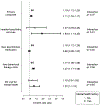Association Between Periviable Delivery and New Onset of or Exacerbation of Existing Mental Health Disorders
- PMID: 36657144
- PMCID: PMC10477003
- DOI: 10.1097/AOG.0000000000005050
Association Between Periviable Delivery and New Onset of or Exacerbation of Existing Mental Health Disorders
Abstract
Objective: To evaluate whether there is an association between periviable delivery and new onset of or exacerbation of existing mental health disorders within 12 months postpartum.
Methods: We conducted a retrospective cohort study of individuals with liveborn singleton neonates delivered at 22 or more weeks of gestation from 2008 to 2017 in the MarketScan Commercial Research Database. The exposure was periviable delivery , defined as delivery from 22 0/7 through 25 6/7 weeks of gestation. The primary outcome was a mental health morbidity composite of one or more of the following: emergency department encounter associated with depression, anxiety, psychosis, posttraumatic stress disorder, adjustment disorder, self-harm, or suicide; new psychotropic medication prescription; new behavioral therapy visit; and inpatient psychiatry admission in the 12 months postdelivery. Secondary outcomes included components of the primary composite. Those with and without periviable delivery were compared using multivariable logistic regression adjusted for clinically relevant covariates, with results reported as adjusted incident rate ratios (aIRRs). Effect modification by history of mental health diagnoses was assessed. Incidence of the primary outcome by 90-day intervals postdelivery was assessed.
Results: Of 2,300,244 included deliveries, 16,275 (0.7%) were periviable. Individuals with periviable delivery were more likely to have a chronic health condition, to have undergone cesarean delivery, and to have experienced severe maternal morbidity. Periviable delivery was associated with a modestly increased risk of the primary composite outcome, occurring in 13.8% of individuals with periviable delivery and 11.0% of individuals without periviable delivery (aIRR 1.18, 95% CI 1.12-1.24). The highest-risk period for the composite primary outcome was the first 90 days in those with periviable delivery compared with those without periviable delivery (51.6% vs 42.4%; incident rate ratio 1.56, 95% CI 1.47-1.66).
Conclusion: Periviable delivery was associated with a modestly increased risk of mental health morbidity in the 12 months postpartum.
Copyright © 2023 by the American College of Obstetricians and Gynecologists. Published by Wolters Kluwer Health, Inc. All rights reserved.
Conflict of interest statement
Financial Disclosure Outside of the submitted work, Torri D. Metz reports personal fees from Pfizer for her role as a medical consultant for a SARS-CoV-2 vaccination in pregnancy study, grants from Pfizer for role as a site PI for SARS-CoV-2 vaccination in pregnancy study, grants from Pfizer for role as a site PI for RSV vaccination in pregnancy study, and grants from Gestvision for role as a site PI for a preeclampsia study. She also reports receiving UpToDate royalties for two topics on trial of labor after cesarean. Michelle L. Debbink reports receiving salary support from the American Board of Obstetrics and Gynecology and the March of Dimes as part of the Reproductive Scientist Development Program. Marcela C. Smid serves as a medical consultant for Gilead Science Incorporated, Organon Inc., and the American Academy of Addiction Psychiatry. Dr. Smid also receives funding from National Institute on Drug Abuse and the Centers for Disease Control and Prevention. The other authors did not report any potential conflicts of interest.
Figures



Similar articles
-
Association between delivering live-born twins and acute psychiatric illness within 1 year of delivery.Am J Obstet Gynecol. 2021 Mar;224(3):302.e1-302.e23. doi: 10.1016/j.ajog.2020.09.005. Epub 2020 Sep 12. Am J Obstet Gynecol. 2021. PMID: 32926857 Free PMC article.
-
Association between mode of delivery and infant survival at 22 and 23 weeks of gestation.Am J Obstet Gynecol MFM. 2021 Jul;3(4):100340. doi: 10.1016/j.ajogmf.2021.100340. Epub 2021 Feb 27. Am J Obstet Gynecol MFM. 2021. PMID: 33652159
-
Association between stillbirth ≥23 weeks gestation and acute psychiatric illness within 1 year of delivery.Am J Obstet Gynecol. 2019 Nov;221(5):491.e1-491.e22. doi: 10.1016/j.ajog.2019.06.027. Epub 2019 Jun 19. Am J Obstet Gynecol. 2019. PMID: 31226297 Free PMC article.
-
Cesarean section on request at 39 weeks: impact on shoulder dystocia, fetal trauma, neonatal encephalopathy, and intrauterine fetal demise.Semin Perinatol. 2006 Oct;30(5):276-87. doi: 10.1053/j.semperi.2006.07.009. Semin Perinatol. 2006. PMID: 17011400 Review.
-
Periviable births: epidemiology and obstetrical antecedents.Semin Perinatol. 2013 Dec;37(6):382-8. doi: 10.1053/j.semperi.2013.06.020. Semin Perinatol. 2013. PMID: 24290393 Review.
References
MeSH terms
Grants and funding
LinkOut - more resources
Full Text Sources
Medical

